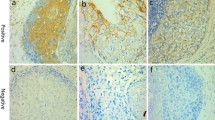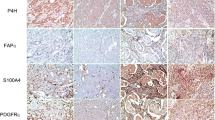Abstract
This study is mainly aimed at evaluating the expression of PC-cell-derived growth factor (PCDGF) in breast cancer and breast adenofibroma, and to compare with other commonly used clinical pathological indices, then to investigate the diagnostic and targeted therapeutic purpose of PCDGF in breast cancer tissue. In this study, we detected the expression of PCDGF, p53 and CerbB-2 in breast cancer tissue and the expression of PCDGF in breast adenofibroma tissue by immunohistochemical method, and analyzed the relationship between them. We found that PCDGF was expressed in most breast cancer tissue, but was not in breast adenofibroma tissue, and the expression of PCDGF was related with the tumor’s pathological category and the expression of estrogen receptor (ER) and progesterone receptor (PR) and p53, but there was no statistical dependability between PCDGF and cerbB-2. From this study, we predict that PCDGF may serve as a marker in the secondary diagnosis of breast cancer, and may participate in the generation and differentiation of breast cancer cells, and become an effective target of therapy for breast cancer.
Similar content being viewed by others
References
Hoskins K, Weber B L. The biology of breast cancer. Curr Opin Oncol, 1994, 6(6): 554–559
Reiss K, Valentinis B, Tu X, Xu S Q, Baserga R. Molecular markers of IGF-I-mediated mitogenesis. Exp Cell Res, 1998, 242(1): 367–372
Tangkeangsirisin W, Serrero G. PC cell-derived growth factor (PCDGF/GP88, progranulin) stimulates migration, invasiveness and VEGF expression in breast cancer cells. Carcinogenesis, 2004, 25(9): 1587–1592
Zanocco-Marani T, Bateman A, Romano G, Valentinis B, He Z H, Baserga R. Biological activities and signaling pathways of the granulin/epithelin precursor. Cancer Res, 1999, 59(20): 5331–5340
Tangkeangsirisin W, Hayashi J, Serrero G. PC cell-derived growth factor mediates tamoxifen resistance and promotes tumor growth of human breast cancer cells. Cancer Res, 2004, 64(5): 1737–1743
Lu R Q, Serrero G. Inhibition of PC cell-derived growth factor (PCDGF, epithelinygranulin precursor) expression by antisense PCDGF cDNA transfection inhibits tumorigenicity of the human breast carcinoma cell line MDA-MB-468. PNAS, 2000, 97(8): 3993–3998
Kuang S Q, Liao L, Zhang H, Lee A V, O’Malley B W, Xu J M. AIB1/SRC-3 deficiency affects insulin-like growth factor I signaling pathway and suppresses v-Ha-ras-induced breast cancer initiation and progression in mice. Cancer Res, 2004, 64(5): 1875–1885
Shi L, Song H P, Liu C P, Huang T. Effect of PC-cell derived growth factor shRNA on estrogen dependent of estrogen receptor negative breast cancer cell lines. Zhonghua Wai Ke Za Zhi, 2007, 45(7): 483–486 (in Chinese).
Huang T, Song H P, Zhang J H. Effect of PCDGF shRNA on growth, proliferation, apoptosis of human breast carcinoma cell line MCF-7 and expression of VEGF. Ai Zheng, 2006, 25(3): 303–307 (in Chinese)
Bhandari V, Bateman A. Structure and chromosomal location of the human granulin gene. Biochem Biophys Res Commun, 1992, 188(1): 57–63
Bateman A, Belcourt D, Bennett H, Lazure C, Solomon S. Granulins, a novel class of peptide from leukocytes. Biochem Biophys Res Commun, 1990, 173(3): 1161–1168
Bhandari V, Giaid A, Bateman A. The complementary deoxyribonucleic acid sequence, tissue distribution, and cellular localiza-tion of the rat granulin precursor. Endocrinology, 1993, 133(6): 2682–2689
Sparro G, Galdenzi G, Eleuteri A M, Angeletti M, Schroeder W, Fioretti E. Isolation and N-terminal sequence of multiple forms of granulins in human urine. Protein Expr Purif, 1997, 10(2): 169–174
Zhang H, Serrero G. Inhibition of the tumorigenicity of the teratoma PC cell line by transfection with antisense cDNA for PC cell-derived growth factor (PCDGF, epithelin/granulin precursor). Proc Natl Acad Sci USA, 1998, 95(24): 14202–14207
Lu R, Serrero G. Inhibition of PC cell-derived growth factor (PCDGF, epithelin/granulin precursor) expression by antisense PCDGF cDNA transfection inhibits tumorigenicity of the human breast carcinoma cell line MDA-MB-468. Proc Natl Acad Sci USA, 2000, 97(8): 3993–3998
Lu R, Serrero G. Mediation of estrogen mitogenic effect in human breast cancer MCF-7 cells by PC cell-derived growth factor (PCDGF/granulin precursor). Proc Natl Acad Sci USA, 2001, 98(1): 142–147
Lu R, Serrero G. Stimulation of PC cell-derived growth factor (epithelin/granulin precursor) expression by estradiol in human breast cancer cells. Biochem Biophys Res Commun, 1999, 256(1): 204–207
Moriya T, Kanomata N, Kozuka Y, Fukumoto M, Iwachido N, Hata S, Takahashi Y, Miura H, Ishida K, Watanabe M. Usefulness of immunohistochemistry for differential diagnosis between benign and malignant breast lesions. Breast Cancer, 2009, 16(3): 173–178
Hosaka N, Ryu T, Cui W, Li Q, Nishida A, Miyake T, Takaki T, Inaba M, Ikehara S. Relationship of p53, Bcl-2, Ki-67 index and E-cadherin expression in early invasive breast cancers with comedonecrosis as an accelerated apoptosis. J Clin Pathol, 2006, 59(7): 692–698
Liau L M, Lallone R L, Seitz R S, Buznikov A, Gregg J P, Kornblum H I, Nelson S F, Bronstein J M. Identification of a human glioma-associated growth factor gene, granulin, using differential immuno-absorption. Cancer Res, 2000, 60(5): 1353–1360
He Z, Bateman A. Progranulin gene expression regulates epithelial cell growth and promotes tumor growth in vivo. Cancer Res, 1999, 59(13): 3222–3229
Naeem M, Nasir A, Aman Z, Ahmad T, Samad A. Frequency of HER-2/neu receptor positivity and its association with other features of breast cancer. J Ayub Med Coll Abbottabad, 2008, 20(3): 23–26
Vinothini G, Murugan R S, Nagini S. Evaluation of molecular markers in a rat model of mammary carcinogenesis. Oncol Res, 2009, 17(10): 483–493
Carlsson J, Soussi T, Persson B. Investigation and prediction of the severity of p53 mutants using parameters from structural calculations. FEBS J, 2009, 276(15): 4142–4155
Vinothini G, Murugan R S, Nagini S. Evaluation of molecular markers in a rat model of mammary carcinogenesis. Oncol Res, 2009, 17(10): 483–493
Seewaldt V L, Mrók K, Sigle R, Dietze E C, Heine K, Hockenbery D M, Hobbs K B, Caldwell L E. Suppression of p53 function in normal human mammary epithelial cells increases sensitivity to extracellular matrix-induced apoptosis. J Cell Biol, 2001, 155(3): 471–486
Sivaraman L, Conneely O M, Medina D, O’Malley B W. p53 is a potential mediator of pregnancy and hormone-induced resistance to mammary carcinogenesis. PNAS, 2001, 98(22): 12379–12384
Shilkaitis A, Green A, Punj V, Steele V, Lubet R, Christov K. Dehydroepiandrosterone inhibits the progression phase of mammary carcinogenesis by inducing cellular senescence via a p16-dependent but p53-independent mechanism. Breast Cancer Res, 2005, 7(6): R1132–R1140
Hirsch F R, Scagliotti G V, Langer C J, Varella-Garcia M, Franklin W A. Epidermal growth factor family of receptors in preneoplasia and lung cancer: perspectives for targeted therapies. Lung Cancer, 2003, 41 Suppl 1: S29–S42
Kim J A. Targeted therapies for the treatment of cancer, Am J Surg, 2003, 186(3): 264–268
Murphy C G, Modi S. HER2 breast cancer therapies: a review. Biologics, 2009, 3: 289–301
Martín-Orozco R M, Almaraz-Pro C, Rodríguez-Ubreva F J, Cortés M A, Ropero S, Colomer R, López-Ruiz P, Colás B. EGF prevents the neuroendocrine differentiation of LNCaP cells induced by serum deprivation: the modulator role of PI3K/Akt. Neoplasia, 2007, 9(8): 614–624
Author information
Authors and Affiliations
Corresponding author
Rights and permissions
About this article
Cite this article
Song, H., Shi, L., Liu, C. et al. Expression of PC-cell-derived growth factor in breast cancer. Front. Med. China 3, 426–430 (2009). https://doi.org/10.1007/s11684-009-0085-7
Received:
Accepted:
Published:
Issue Date:
DOI: https://doi.org/10.1007/s11684-009-0085-7




